A Braille Reading System Based on Electrotactile Display With Flexible Electrode Array
2022-04-15ZiliangZhouYichengYangandHonghaiLiu
Ziliang Zhou,, Yicheng Yang,, and Honghai Liu,
Dear editor,
Due to visual impairment and lack of social attention, the reading problem of the blind has not been well resolved. Many existing Braille reading devices still have many problems and are not accepted by the public. This paper developed a portable Braille reading system based on electrotactile display technology. The proposed system is composed of a six-channel electrotactile stimulator, a flexible electrode array for Braille display and a graphical user interface (GUI) for monitoring and control. Based on the flexibility of the system, two Braille reading strategies have been designed: spatial mode and sequential mode. The system was preliminary tested by six sighted subjects. The results showed that subjects were able to recognize Braille characters with more than 80% accuracy within less than 10 seconds for the initial use.Compared to existing Braille reading systems, this system is portable,wearable and flexible in control.
Individuals who are blind or visually impaired (BVI) will face great inconvenience in many aspects of life, of which text communication is a very important part. In order to solve the reading problem, the six-point Braille system was invented in 1824. The Braille system uses different combinations of raised dots to represent different characters, and is read by fingertips. However, the current paper-used Braille reading system faces many problems, such as high cost, large in size and not portable. To overcome the problem of Braille books, the development of efficient Braille reading devices has been concerned by many researchers.
At present, one-cell Braille displays with mechanical structures were adopted by most Braille reading devices, which used pin-based tactile displays as Braille displays and the pins were actuated based on piezoelectricity [1], [2], pneumatic valves [3], or electromagnetic forces [4], [5]. However, there are still a lot of problems to be solved,such as large size, high cost, higher operating voltage and slow response. Therefore, the existed Braille reading devices are difficult to be accepted by the public.
Braille reading is achieved through haptic interaction. Haptic interaction takes many forms and has a wide range of applications[6], [7]. An electrotactile display is a haptic device that directly generates sensations with electric current. By using surface electrodes, the electrotactile display can stimulate receptors within the skin [8]. Electrotactile displays take many different forms and can be developed for various purposes, including spatial guidance,feedback in human-computer interaction and sensory substitution [9],[10]. The previous proposed applications indicates that it has the advantages of small size, low energy consumption and fast response.
Based on the electrotactile technologies, this study focused on applying them in Braille reading and designing a system which is portable, wearable, low energy consumption and flexible. The main contributions of this article were: 1) An stimulation hardware was proposed that was capable of generating 6-channel monophasic pulses. 2) A wearable and portable flexible electrode array at fingertips has been designed to simulate the touch reading. 3) A graphical user interface was developed to control the Braille output.4) Two Braille reading strategies have been designed. The framework of the Braille reading system is shown in Fig. 1. The system is mainly composed of three parts: stimulator, Braille display and GUI, which will be introduced in the following subsections.
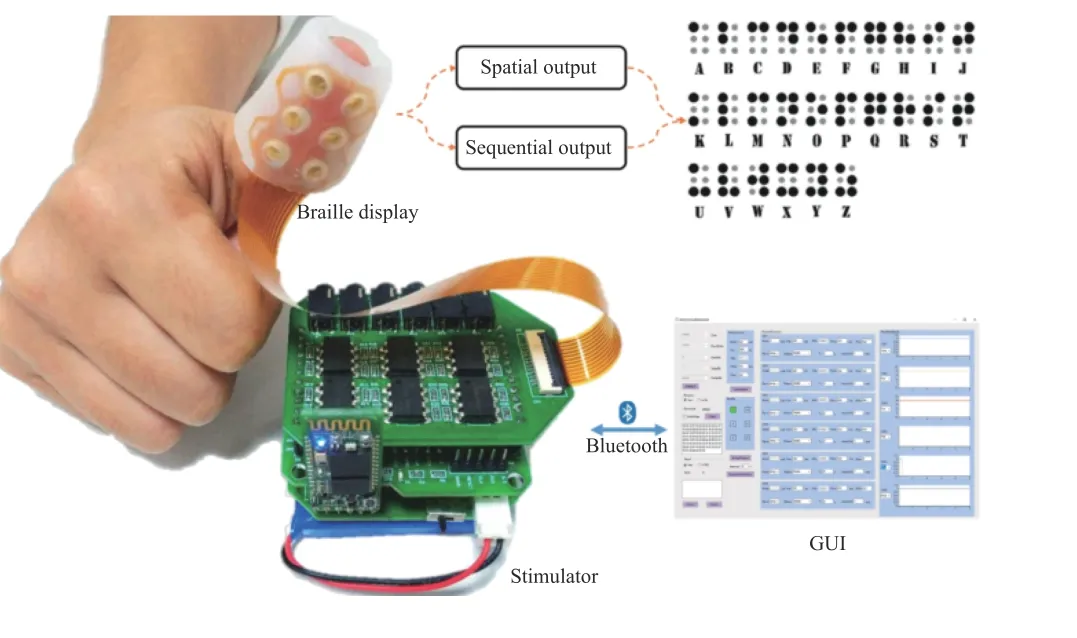
Fig. 1. The framework of Braille reading system: GUI for monitoring and Braille controlling; Stimulator for pulses generating; Electrode Array for Braille display.
Stimulator: The six-channel stimulator designed is composed of three detached modules: power supply, output control and pulses output. The parameters of the stimulator are listed in Table 1.Constant current stimulation is adopted due to the impedance variations of the skin. According to the available literature, the amplitude of the current normally adopted ranges from 0 mA to 6 mA and the pulses with a frequency range from 60 Hz to 400 Hz could generate smooth and comfortable sensations [11]. For pulse width, it is suggested to keep it shorter than 500 us to avoid pain [12].Therefore, the parameter range of the stimulator can meet the operating requirement.
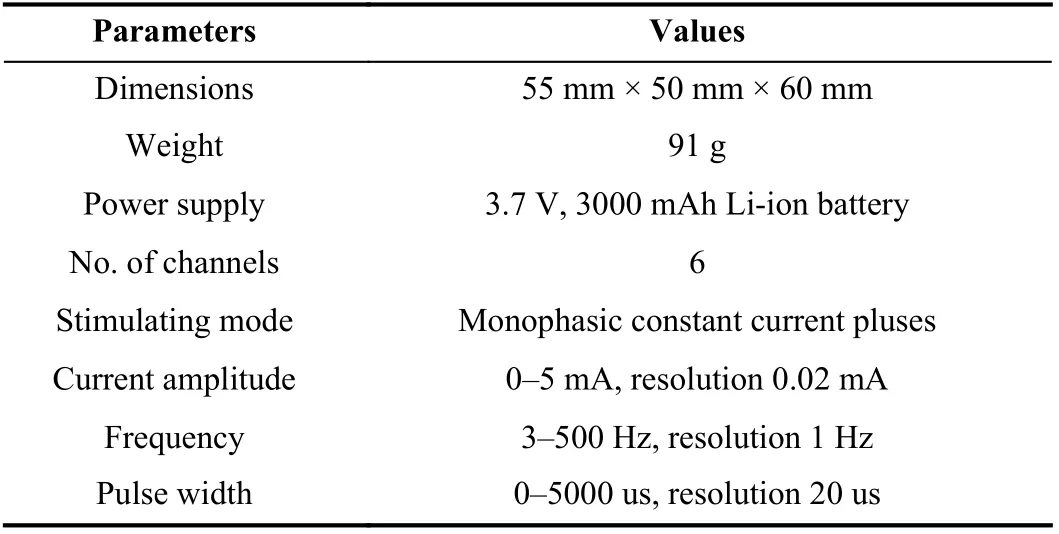
Table 1.Parameters of the Stimulator
Braille display: The 6 electrodes of the display are arranged according to the Braille. In order to be light and flexible, the tactile display electrodes are made on flexible printed circuit (FPC).Through the fabrication technology in soft robotics [13], the display is casting fabricated by combining FPC electrode with high performance silicone rubber. The fabrication process is shown in Fig. 2.The entire electrode is cast into finger-cot shape with a thickness of 3 mm. Six stimulating electrodes are on the front of the FPC. The common reference electrode is on the opposite. The Braille display is worn at the right thumb and is read by active scanning with right index finger. An FPC connector is used to transmitter pulses signals from stimulator to Braille display.
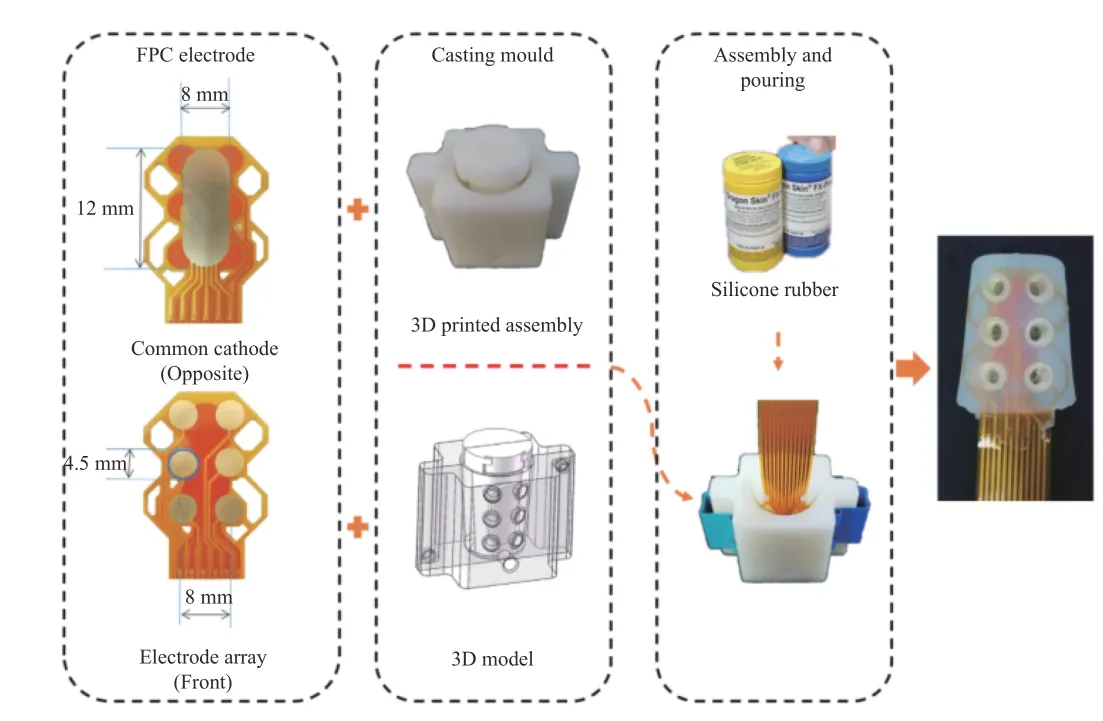
Fig. 2. Fabricating of the Braille display.
Graphical user interface: In order to monitor and control the system, a GUI based on C# is developed. It mainly includes three parts: 1) Control of serial port connection with hardware and data monitoring for debugging, where different parameters such as serial port numbers and baud rate can be set and communication data can be manually sent and received; 2) Parameter control of each channel and Braille output control, where the current amplitude can be set uniformly. Frequency, pulse width and phase of each channel can be set separately and the sinusoidal wave and triangular wave can be modulated for these parameters. Meanwhile, the output Braille can be set through Braille control panel; 3) Monitoring of the stimulator status, where the chart can display the parameters of each channel in real time to monitor the dynamic changes.
Braille display methods: To adapt to different usage scenarios,there are two strategies of Braille output designed in this system. Fig. 3 shows the schematics of the two Braille reading strategies
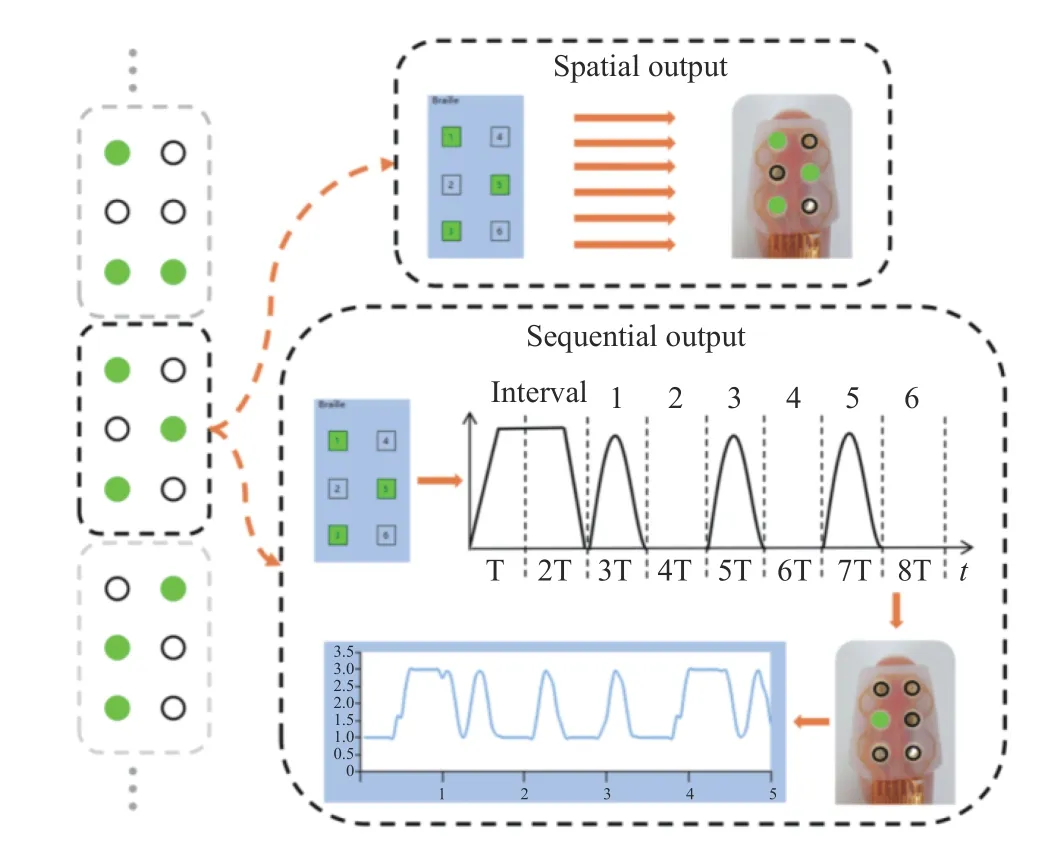
Fig. 3. Two output modes of the Braille reading strategies: 1) Spatial output with six channels for actively Braille reading by fingertip. Green dots indicate that the channels are open. 2) Sequential output with one output channel for passive intensity change perception by fingertip. The green dot in the figure marks the output channel.
● Spatial output mode: Since the electrode arrangement of Braille display is the same as Braille text, and each channel can be controlled individually, channels can be directly controlled to be on or off in accordance with the Braille text. This output mode is similar to directly touching Braille text. Subjects can read individual Braille text by identifying the locations of the stimulus. This mode is intuitive and the advantage is that the sensation is close to the real touching with a higher reading efficiency.
● Sequential output mode: Another idea to output the Braille text is to modulate the pulses over time. The specific method is shown in Fig. 3. The time to display one Braille character is set to eight periods. During the first two periods, the output remains high to be the interval. The next six periods correspond to six points of the Braille character in order. This mode simulates the passive perception and subjects need to distinguish the stimulation changes over time.
Experimental design: In order to verify the effect of this Braille reading system, a set of Braille reading experiments were designed.A total of 6 sighted subjects (Age: 24.2 ± 1.47) who had no Braille reading experience were recruited. All subjects had signed the informed consents before the experiment. Before the formal experiments, a pre-experiment for each subject was conducted to find the appropriate output parameters. This experiment includes two subexperiments: spatial Braille reading and sequential Braille reading.Letters from the alphabet were randomly selected for Braille display.The subjects were asked to close their eyes and read the Braille by their index fingers. Reading results were recorded, and the time between the Braille output and the subject’s utterance of the Braille was measured by the experimental recorder.
Results: The results of reading experiment are shown in Fig. 4.The spatial reading accuracy of all subjects is 81.7 ± 21.4 %, while the sequential reading accuracy is 88.3 ± 20.4 %. There is no significant differences (p= 0.593) between two modes in reading accuracy. The spatial reading time of all subjects is 8.28 ± 0.814 s,while the sequential reading time is 18.01 ± 5.70 s. The differences between two modes in reading time is significant (p< 0.001).
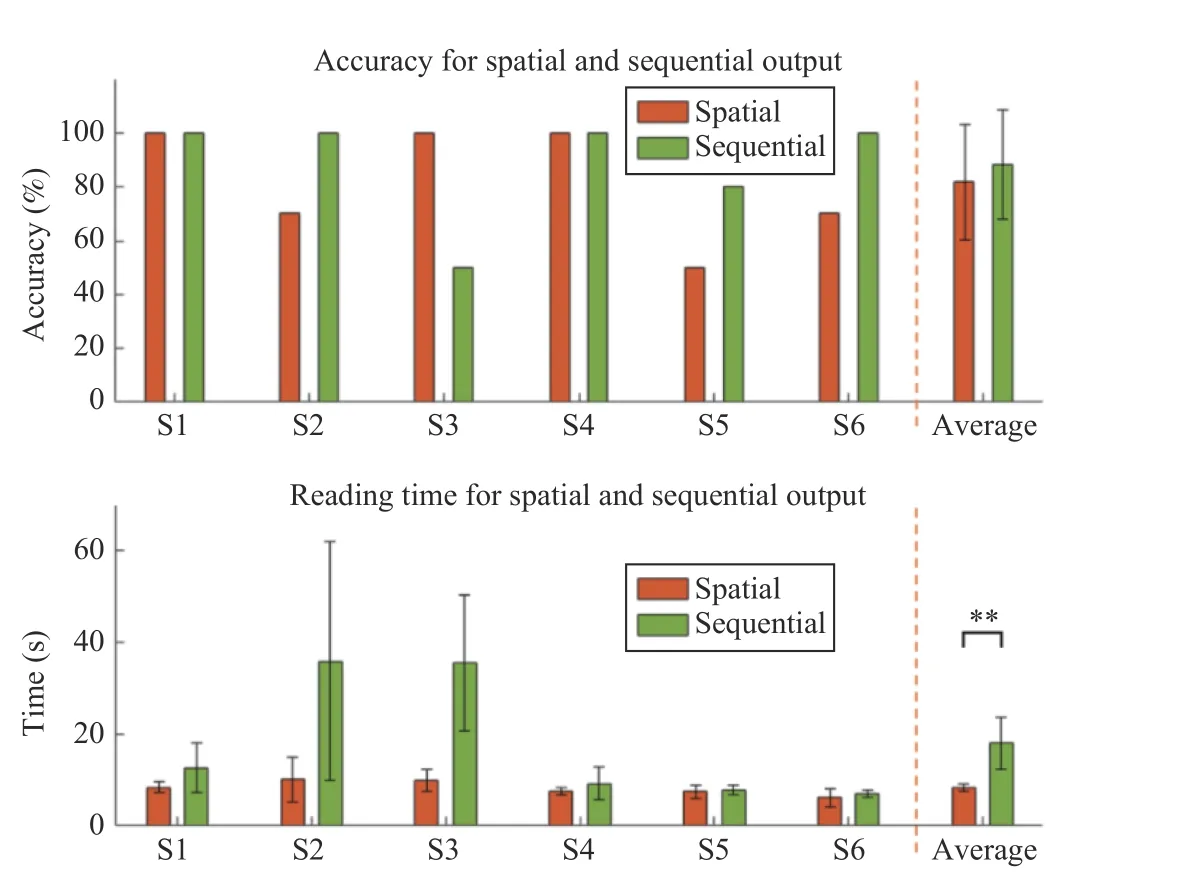
Fig. 4. The comparison of reading accuracy and time across all subjects based on spatial and sequential output. Error bars represent ± SD and “**” denotes p < 0.001.
Discussions and conclusions: The comparison with Braille systems based on different actuators is shown in Table 2, which indicates that electrotactile-based Braille reading system has advantages in terms of portability, wearability, energy consumption and cost. Although the experimental results show that the reading efficiency is not high enough, there is a tendency of improving with training. Both reading methods have their own advantages in terms ofreading time and accuracy. Individual differences in subjects were significant. The results of this paper have demonstrated the potential of electrotactile feedback in Braille reading. Studying the human ability to understand electrotactile encoded information and designing an efficient Braille display method is the future direction.

Table 2.Comparison With Selective Braille Reading Systems Found in Literature
Acknowledgments: This work was supported by the Shenzhen Science and Technology Program (JCYJ20210324120214040), the Guangdong Science and Technology Research Council(2020B1515120064), and the National Natural Science Foundation of China (61733011, 62003222).
杂志排行
IEEE/CAA Journal of Automatica Sinica的其它文章
- Energy Theft Detection in Smart Grids: Taxonomy,Comparative Analysis, Challenges, and Future Research Directions
- On the System Performance of Mobile Edge Computing in an Uplink NOMA WSN With a Multiantenna Access Point Over Nakagami-m Fading
- Continuous-Time Prediction of Industrial Paste Thickener System With Differential ODE-Net
- Unmanned Aerial Vehicles: Control Methods and Future Challenges
- A Short-Term Precipitation Prediction Model Based on Spatiotemporal Convolution Network and Ensemble Empirical Mode Decomposition
- A Sandwich Control System with Dual Stochastic Impulses
